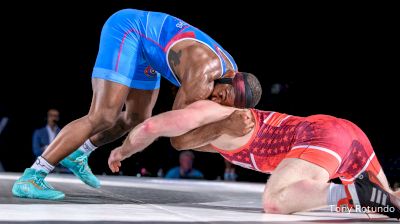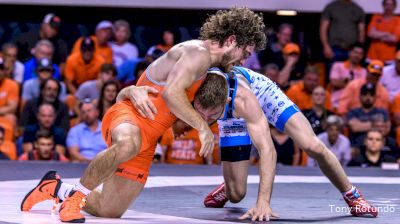The Grounded Rule Is Broken But The Fix Is Simple
The Grounded Rule Is Broken But The Fix Is Simple
A breakdown of how the grounding and step out rule creates confusion for fans, athletes and officials as well as our solution to fix this problem.

Final X was an incredible display of USA’s best wrestlers however the wrestling revealed confusion in 1 scoring position - the step-out/grounded position. From both Final X Stillwater and NYC, many fans, wrestlers, and coaches were left asking the questions - What is a step-out and what isn’t? Why is the same position called “grounded” one time but a step-out or caution another? In the article below, we’ll look at where the confusion comes from, where we see the contradiction the most, and what are the simple solutions moving forward.
The Step-Out - Simple On The Surface
The step-out seems straightforward: You take your opponent out of bounds, and you get up a point. However, looking at the UWW rule book, it’s not so simple. It defines a step-out as "(1 point is awarded) To the wrestler whose opponent goes in the protection zone with one entire foot (in standing position) without executing a hold."
The question from that definition - what is the standing position? Most American folkstyle fans will equate the standing position to the “neutral position” and the “parterre” position in freestyle to top/bottom wrestling. However, that is not the case in freestyle wrestling as the UWW rule book explains the parterre position as any time a wrestler has a knee on the mat. In fact, the USA Wrestling rule book does a great job of explaining this: “Parterre refers to mat wrestling, defined as the defensive wrestler having one or both of his/her knees on the mat; control is not required to be in this position.” This means wrestlers are in the parterre position anytime they go to a knee, even if they haven't given up a takedown or exposure points.
At this point, the step-out point has become slightly more complicated but it’s still easy enough for the casual freestyle wrestling fan to understand. If you go out of bounds on your feet, you give up a point. If you go out of bounds on one knee (in parterre position) you don’t give up a point. UWW devotes over an hour of a training session video on various out-of-bounds situations and one of their head referees explains when to call the position a step-out or grounded at around 26:45 in the video below.
At 26:45 begins to talk about defining standing position and parterre position.
Unfortunately, It’s Not That Simple
With the implementation of the “grounded rule”, we’ve seen countless wrestlers take advantage of the safety of staying on a knee or intentionally going to a knee when getting close to out of bounds in order to avoid giving up a step-out point. Wrestlers are the ultimate competitors and will find a way to use a rule to their advantage if given the opportunity.
Both United World Wrestling and USA Wrestling have tried to address this issue in different ways. First, the USA Wrestling rulebook says,”...if Red snaps Blue down into a front headlock with Blue’s knees on the mat and Blue decides to back himself out of bounds to avoid being turned, fleeing the mat could be called and the wrestlers would restart in parterre, Red being on top.” In this case, referees have the discretion to judge when a wrestler is intentionally going to a knee to avoid the step-out and award the attacking wrestler with 1-point and a caution for fleeing the mat.
UWW does not address the situation in the rulebook but instead in their training videos. The referee instructing the training affirms the above position for awarding a caution +1 described in USA Wrestling’s rulebook but also gives the referee the ability to call a step-out when the defensive wrestler “intentionally sits not to lose 1 point.” You can watch this explanation at 30 minutes in the video below
To summarize, a referee has the ability to make 1 of 3 calls when a wrestler goes out of bounds in parterre (one knee on the mat):
- Grounded - no points
- Caution for fleeing the mat - 1 point
- Step-out for intentionally grounding - 1 point
Subjectivity = Contradictions
The grounded rule, and exceptions to the rule, leave the enforcement entirely to the opinion of the referee committee. Obviously, that’s the case in every rule, however, subjectivity abounds in how step-outs are called. And it’s not the referees' fault - they have to make a decision in a matter of seconds whether or not a wrestler intentionally went to a knee or arrived there because of “natural action” from the wrestling match. In some cases, going to a knee is the proper defense against an attack - is that punishable with a step-out or caution +1? Simply put, the grounded position and enforcement of the step-out have become subjective on a broad scale in freestyle wrestling.
The outcome of this subjective rule enforcement? Contradictions! The two Final X events highlighted these contradictions in two major matches and positions. First, the Jordan Burroughs - Chance Marsteller series. In Match 2 Burroughs had Marsteller in the front headlock position and Marsteller notably was on his knees and was pushed out three times. By definition he was grounded and in the parterre position. However, the fourth time he was hit with a caution +1 for fleeing the mat and the fifth with a step-out. Overall, it leaves fans confused with how that position should be called.
See how the grounded position/step-out was called 3 different ways in the Burroughs vs Marsteller series:

The other position that exposed the inconsistencies in the enforcement of the grounded/step-out rule was the seatbelt/whizzer position. This was primarily on display in the Daton Fix vs Seth Gross series. Numerous times Gross and Fix would be on the edge of the mat in the whizzer-seatbelt position and when Fix would go to his knees, Gross received a point for a step-out. In at least one position, Fix never even went out of bounds. The problem? In the past (2019 US Open against Gilman in the video below), Fix has used this position to his advantage and never conceded a point from this position. It’s also worth noting that at an international tournament going on at the same time as Final X the same seatbelt-whizzer position was called inconsistently. Check out clips of those examples in the video below.
The inconsistencies in the seatbelt-whizzer position at US Open, Final X, and International Tournaments;

The Answer
One thing is clear regarding grounding rules and the step-out - change is needed. The current state of the rule places an unreasonable amount of pressure on refs to enforce positions based on the intent of a wrestler. If nothing changes, we’ll continue to see different calls for the same wrestling positions. That is unacceptable.
So what’s the answer? Simplicity. A “black and white” step-out rule. Whoever goes out of bounds first should surrender a point regardless of whether or not they’re on a knee. This would simplify the understanding of the rule for fans and athletes while also simplifying the enforcement of the rule for referees.
Wrestling is already a niche sport and freestyle wrestling is a "niche within the niche". In order to draw in casual fans, the rules need to be easy for everyone to understand. At its core, out of bounds is a very simple concept but has been made overly complicated by the grounded rule. Changing this rule to a "black and white" step-out rule would move the sport in a positive direction making it much easier for every fan to follow.
As always, we'd love to hear your feedback! Send me your ideas to how to fix the step-out/grounded rule or any questions you may have regarding a specific instance of inconsistency in how a step-out was called - send all feedback to jonathan.kozak@flosports.tv or on Twitter @KozakJon.